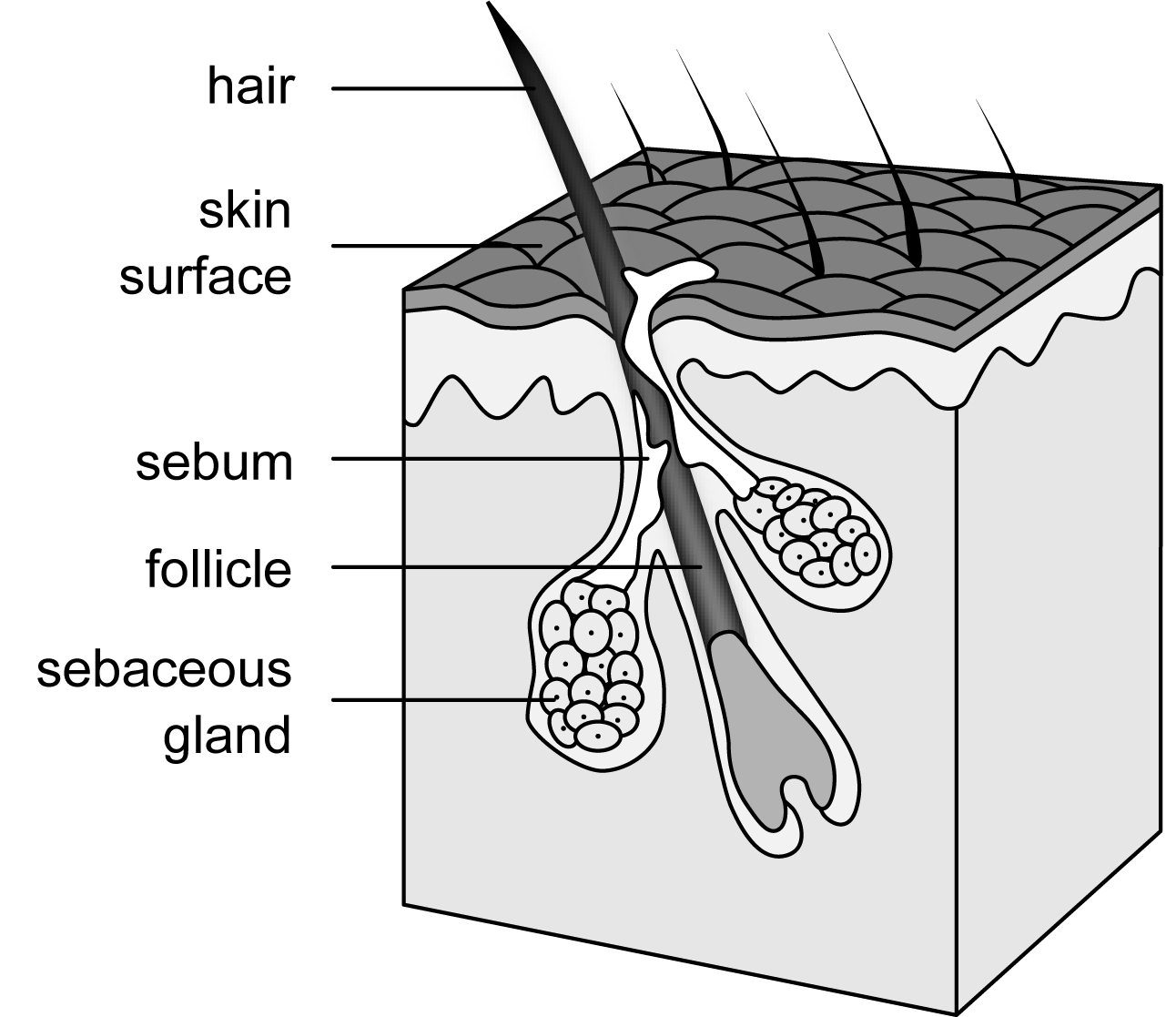Background
 Today's biologic quarry is the hair follicle, depicted on the left. While we all take hair for granted (perhaps the lyric "you don't know what you got till it's gone" is applicable), it is a complex structure lying within the skin. Stem cells are responsible for its growth and coloration, more about them shortly, and the milieu of hormones, as well as cell mediators, controls where hair grows along with its texture. In addition to housing a sebaceous gland, hair follicles have muscles, the arrector pili, responsible for raising your hair, as in the phrase "hair-raising scare," which is a real thing.
Today's biologic quarry is the hair follicle, depicted on the left. While we all take hair for granted (perhaps the lyric "you don't know what you got till it's gone" is applicable), it is a complex structure lying within the skin. Stem cells are responsible for its growth and coloration, more about them shortly, and the milieu of hormones, as well as cell mediators, controls where hair grows along with its texture. In addition to housing a sebaceous gland, hair follicles have muscles, the arrector pili, responsible for raising your hair, as in the phrase "hair-raising scare," which is a real thing.
Hair follicles go through stages of growth (anagen), rest (telogen), loss (catagen and exogen), as well as renewal (kenogen). The bulbous area at the bottom of the follicle contains those previously mentioned stem cells. Hair follicle stem cells (HFSC) derived embryologically from the same layer as our skin produces a new hair follicle. In contrast, melanocyte stem cells (MeSC) derived from the layer that forms our nervous system, provides pigment to color the hair. During anagen, these stem cells are active; otherwise, they just hang out.
The Study
Looking at the pictures of our recent Presidents over two-terms suggests that stress is involved. But how? To find an answer, the researchers made use of black-coated mice, in a series of increasingly focused experiments.
- First, they demonstrated that stress does result in more grey, well actually, uncolored hair. Mice that were restrained, or subject to chronic unpredictable stress (my kids), or pain-induced stress all became noticeably grey after 3-5 hair cycles (anagen to kenogen). Pain was the quickest and the most pronounced.
- Stress, in mice and humans, results in the release of stress corticosteroids and noradrenaline, associated with "fight or flight." When pain perception was blocked, the effect of pain on greying hair was lost, suggesting that this pathway was responsible for the follicular changes.
- When a painful-stimuli was applied during anagen, the follicle's growth phase, melanocyte stem cells rapidly diminished, although the differentiated ones continued to produce hair coloration. But in the next growth cycle, the lost MeSCs were not replaced, and "unpigmented hairs emerged." The researchers subsequently found the same loss of MeSCs when painful stimuli were applied during the resting phase of hair growth. Stress causes the permanent loss of these stem cells.
- One theory has suggested that the immune system mediates this stress response, but in mice lacking T and B cells, the greying still occurred, ruling out this hypothesis
- Given the prominent rise in corticosteroids and adrenaline with stress, especially pain, this was considered as an alternative mechanism. Blocking the receptors to corticosteroids and noradrenaline failed to prevent grey hair; providing exogenous corticosteroids, and noradrenaline didn't create grey hair. Even removing the adrenal gland, the source of these hormones, did not prevent stress from altering those MeSCs
- The remaining source of noradrenaline is the sympathetic nervous system, branches of which lie in close proximity to the hair follicles and come from the same embryonic tissue as those MeSCs, the neural crest. As it turned out pain lead to an immediate sympathetic response. Blocking the sympathetic response prevented the loss of MeSCs, while activating those fibers in the absence of stress, resulted in MeSCs loss.
- In a final series of experiments, the researchers demonstrated that it was the activation of MeSCs due to stress-induced stimulation of the sympathetic nervous system that resulted in their ultimate depletion and loss of hair coloration.
So yes, my children's antics did turn my hair grey, a hair color I have earned, but not directly. It required the assistance of my sympathetic nervous system. And it may explain why some people under stress retain their hair color; they may well have more of the melanocyte stem cells to burn through. It also points towards the belief that our autonomic nervous system, of which the sympathetics are one component, has a role in cell differentiation and tissue maintenance. Perhaps being more chill can adds days to your life as well as less grey in your hair.
Note:
[1] I attribute my hair loss, on the other hand, to my wife.
Source: Hyperactivation of sympathetic nerves drives depletion of melanocyte stem cells Nature DOI: 10.1038/s41586-020-1935-3
Image of hair follicle courtesy of Helix84derivative work in Wikimedia



